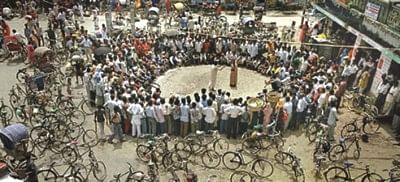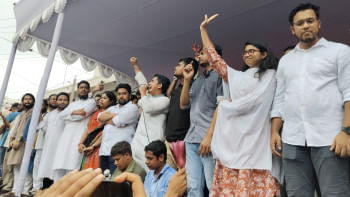Theatre of the Oppressed

Theatre of the Oppressed involves the audience, transforming them from mere spectators to centre stage as “spec actors”.
Vignettes of women impacted by violence from different parts of India were displayed in a photographic exhibition held recently in Delhi. The exhibition went alongside a seminar titled, “Women in Conflict Zones: Survivors and Peace Makers.” The meet was organised by Women's Feature Service (WFS) along with the International Committee of the Red Cross (ICRC).
The photographs captured the stark reality of women caught in the crossfire of violence in India. A photo, titled “The Power of Love,” depicts 48-year-old Asma Khan, a warden from a home run by Zakhat Foundation. The home shelters and educates children displaced by the 2002 Gujarat riots. Says Asma, “There is nothing greater than the power of love, it transforms everything.'
Also among the subjects of the exhibition is the 55-year-old Raj Kaur from rural Punjab, who lost both her legs in a landmine. In the photograph she sits on a straw cot with her prosthetic aids. “I want to let people know my plight. I earned almost Rs 4,000 a month as an agricultural labourer. The accident has left me totally incapacitated,” she says.
Then there's a photograph, which reveals how culture and the arts can lend a voice of sanity in the midst of conflict, tragedy, injustice and turmoil. In “Life's a Stage”, Jaya Iyer theatre activist and pioneer of the “Theatre of the Oppressed” (TOO) method in India, is seen involving the audience, transforming them from mere spectators to centre stage as “Spec actors”.
To amplify on this form of theatre: the relationship of the oppressor and oppressed is firmly established in the minds of the audience, who is then invited to participate in the play and bring it to one or many conclusions. This method deploys public spaces like bus stops, cafes and traffic junctions where the play may held -- often without the audience realising it.
Jaya also holds workshops to empower people to deal with conflicts -- be it the violence between the local and migrant settlers in the Assam tea gardens or gender-based violence.
TOO was the brainchild of Augusto Boal, Brazilian activist and revolutionary. The method was created in the early 1960s as a way to establish a dialogue between audience, director and actor that encouraged political activism aimed at transforming oppressive realities. Boal's revolutionary ideas resulted in his arrest and torture by the Brazilian dictatorship, which was in power at the time. Eventually he was exiled to Argentina and developed his practice there as well as in Peru before his return to his homeland after the fall of the military regime.
Today the TOO method is taught globally, in universities and community-based settings, including TOO institutes in every continent.
Compiled by Cultural Correspondent

 For all latest news, follow The Daily Star's Google News channel.
For all latest news, follow The Daily Star's Google News channel. 



Comments